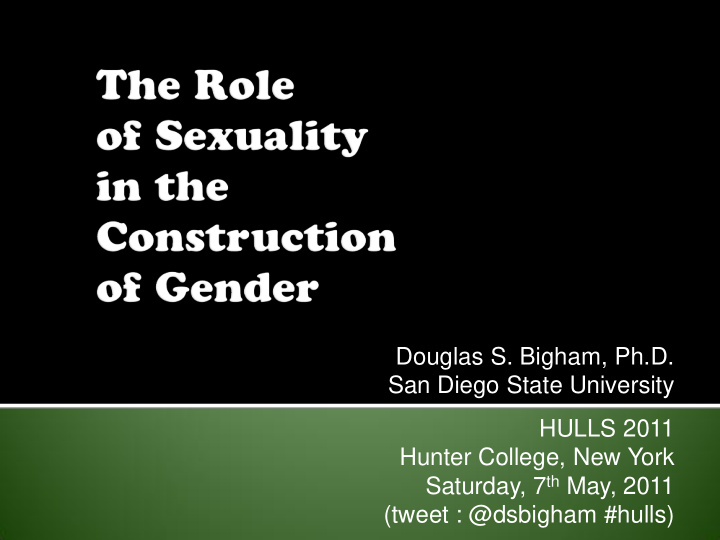



Douglas S. Bigham, Ph.D. San Diego State University HULLS 2011 Hunter College, New York Saturday, 7 th May, 2011 (tweet : @dsbigham #hulls)
Gender is pervasive social histories / social access freedoms / mobility sanctions / expression Gender is compositional sex sexuality power
Female vowel space is, on average, larger than male vowel space.
Females have shorter vocal tracts Gender = height ? Anatomical differences cannot account for the kinds or magnitudes of difference between male and female speakers Fant 1975 ; Diehl, et al. 1996
Men and women participate differently in sociolinguistic variation Fisher 1958 ; Tannen 1990 ; Labov 2001 ; Milroy & Gordon 2003 ; Eckert 2000 ; Coates 2003 women lead change; yet are overtly conservative Girls are producers ~ social engineers women use community-level, wide-solidarity forms... while men use group-level, close-solidarity forms
Problems? “women” “girls” “boys” “men” = BINARY GENDER Implicit erasure of non-normative genders
Discourse-based approaches What do “gays” talk about & how? Leap 1996; Barrett 1999; Cameron & Kulick 2003 Phonetic-based approaches What constitutes “Gay Speech”? Gaudio 1994; Podesva et al. 2001; Levon 2007
Problems? “Queer Speech” vs. “queer speakers” Speaker sexuality as a factor for categorization has largely been ignored Where does Gay Man belong in standard sociolinguistic (esp. variationist) work?
Sex+Sexuality = GENDER SEX→ biologically biologically other SEXUALITY↓ male female “men” “women” Hetero-normative “gay” “lesbian” Homo-normative “trans” other Problems? “other” and “trans” ... ?
11 heteronormative females (“women”) 15 heteronormative males (“men”) 2 homonormative females (“lesbians”) 4 homonormative males (“gays”) Emerging Adults in a university setting Dialect contact Southern Illinois South-Midland + Chicagoland NCS
LOT ▪ raising ▪ merger with THOUGHT GOOSE ▪ fronting FOOT ▪ fronting KIT ▪ not doing anything interesting at all
Variation by GENDER “Gays” show the most progressive variants “Women” follow “Gays” in progressive variants “Men” & “Lesbians” use the most conservative forms Furthermore… backed-KIT variant discovered Ta-da! Sexuality is important in sociolinguistic research, even if sexuality per se isn’t under investigation …but why should this be the case?
Males and Females… ▪ are afforded different opportunities ▪ engage in different kinds of networks (women tend toward more loose connections) ▪ conceptualize sex & sexuality differently ▪ Women are “community - oriented” ▪ Men are “self - oriented” ▪ Can a person be both? Neither? Gays and Lesbians… ▪ ?
Gender is… ▪ social & external ▪ personal & internal ▪ developed early (2-4 years) ▪ “the cultural meanings that the sexed body assumes” (Butler 1999) ▪ labeling & marking Are (straight) men gender free?
Performance Speech ▪ Schilling-Estes 1998; Trester 2007 ▪ Sock puppets require vocal performance above all else “Gay” and “Straight” sock puppets ▪ sex- and sexuality-matched dyads ▪ one “straight” performance, one “gay” performance
Scenario One: Chris and Jesse Chris and Jesse are two friends who met each other at UT last year. This year, they’re both very busy and haven’t seen each other much, but today, they bumped into one another outside the union. Both of them have a couple of hours free and they have decided to hang out. Unfortunately, they can’t decide what to do. Chris wants to go to a movie, but Jesse wants to go get lunch. Eventually, they decide to just go downtown. Your job is to show how Chris and Jesse talk through their different ideas and eventually reach a solution that neither one had thought of at the beginning. Take as much time as you like.
[Video Slides removed for web content] Homosexual actors, gay characters Homosexual actors, straight characters Heterosexual actors, gay characters Heterosexual actors, straight characters
Phonology ▪ precise speech vs. mumbled speech ▪ -ing vs. - in’ … -ing is always gay, -in ’ is variably straight Lexicon ▪ feminine address forms – exclusively homosexual ▪ solidarity forms ( dude, man ) excessive in straight speech Discourse ▪ straight men love food, beer, and sex ▪ straight men are more agro than gay men ▪ Kiesling: power, competition, dominance as solidarity
“Straight Man” ▪ clearly, not an unmarked gender ▪ accessible to both hetero- and homosexual actors ▪ Coates: men are lawyers, bowlers, etc. but not “men” Disembodied Gender ? ▪ heterosexual males =/= “straight man” ▪ Could all genders be disembodied, then?
[Video Slides removed for web content] Homosexual actors, gay characters Homosexual actors, straight characters Heterosexual actors, gay characters Heterosexual actors, straight characters
Third-Wave Sociolinguistics ▪ Variables as indexical, no top-down categories But… People & society USE sex- linked “gender” Gender is part of the hegemonic marketplace First- and Second-Wave Sociolx. are still around Gay & Lesbian speakers account for 4~10% of randomly selected data Speaker sexuality can no longer be ignored, conflated, or overlooked. It must be incorporated.
Douglas S. Bigham, Ph.D. San Diego State University douglas.s.bigham@gmail.com @dsbigham http://dsbigham.net
Recommend
More recommend